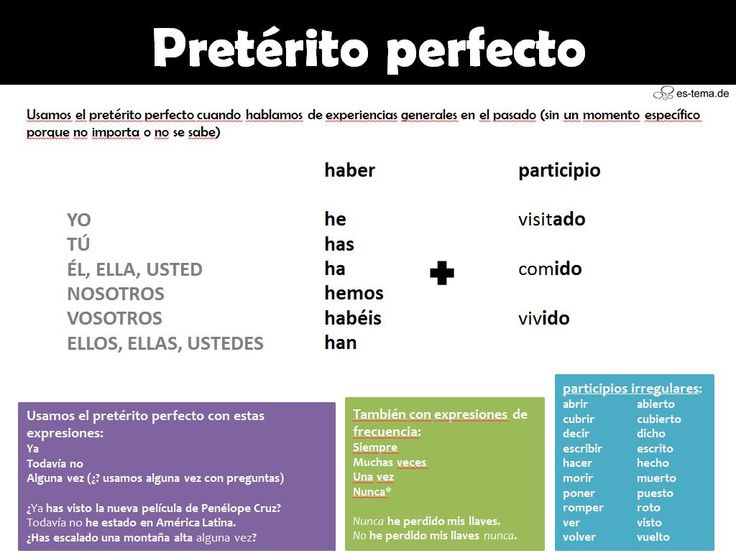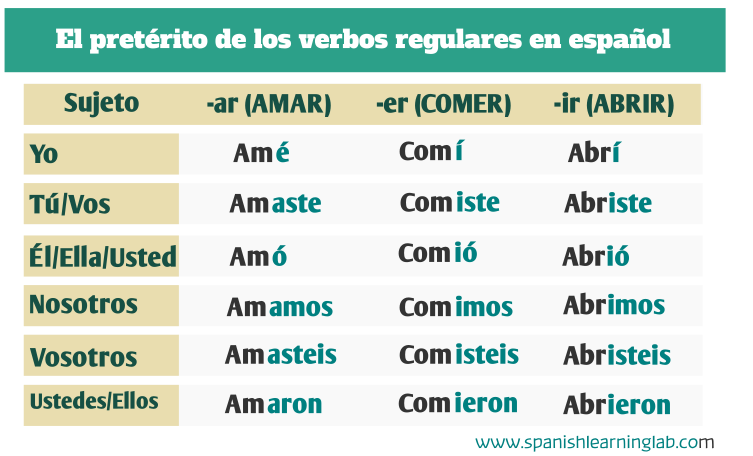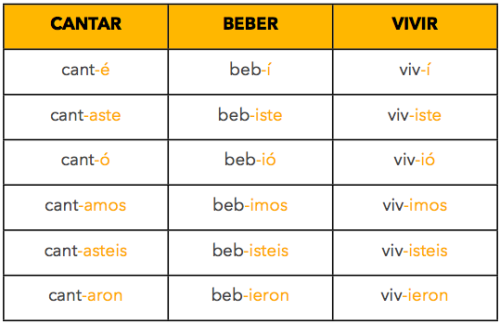In this video presentation you can learn the general rules for conjugating regular Spanish verbs in the:
- Pretérito Perfecto Simple (Preterite) tense
- Indicativo mood
More information on how to conjugate both regular and irregular verbs in this tense, as well as example sentences, may be found below the video.
Note the tense timeline
The ability to properly locate the desired position on the timeline is a crucial skill for proper use of tenses. So pay attention to the timeline in our lessons and visualize it while speaking, listening, writing and reading. After some practice you’ll be able to select the right tense to use much easier.

Video Presentation
How to create and use the Preterite tense in Spanish
The Preterite tense is the basic past tense in Spanish. Most of the verbs conjugate regularly here, and the irregular cases have logical rules, so memorization is rarely necessary. Note that you can easily remind yourself of the rules each time you use the conjugator. Just place the mouse cursor over an exception (printed in red color).
We also have spelling corrections, which are usually not considered irregularities. They apply generally to some combinations of letters, so the rules for using them are exactly the same in case of any type of a Spanish word. For example, plural forms of nouns sometimes need a spelling correction. Because they are limited neither to only verbs nor to any particular tense, we describe the spelling corrections in a separate article.
Regular verb conjugation in Spanish Preterite tense
Pretérito Perfecto Simple belongs to the simple tenses group, which means that all of its conjugated forms are one word long. There are also compound (compuesto) tenses in Spanish language, where each inflected verb form consists of two words.
The basis for this conjugation is the stem of the verb, so we need to start by splitting the infinitive into a stem and an ending. It’s easy to do. Simply remove two letters from the end of the infinitive form to get the ending — one of -ar, -er or -ir. What’s left is the stem.
For example, if we take the verb tomar and cut off the last two letters, we will get:
- the stem: tom-
- and the ending: -ar
Next, to the stem of the infinitive we add an ending specific to a particular grammatical person to create this person’s form. Continuing our example, if we wanted to create the form for the 1st person singular (yo) of the verb tomar, we would add to the stem tom- the ending -o to get tomo.
The endings used in Pretérito Perfecto Simple de Indicativo
The two images below present the endings used in Pretérito Perfecto Simple. Note the shapes and colors of the letters. Find the similarities and differences between the sets. It should help you find patterns and make it easier to remember them. For instance, notice that:
- The 2nd person singular (tú) always ends with the letters ste
- The 2nd person plural (vosotros/vosotras) always ends with the letters steis, and it’s actually equal to the entire tú ending plus the letters is
- The 3rd person singular (él/ella/usted) always ends with the vowel ó
- The 1nd person plural (nosotros/nosotras) always ends with the letters mos.
- The 3rd person plural (ellos/ellas/ustedes) always ends with the letters ron.
- The 1st & 3rd persons singular (yo & él/ella/usted) always get an accent over the last vowel of their ending.
Spend some time looking for more patterns, then try writing all the endings down just from your memory.

These endings are for the -ar verb group. And that’s an example of comprar conjugation:
| singular | plural | ||
|---|---|---|---|
| yo | compré | nosotros/nosotras | compramos |
| tú | compraste | vosotros/vosotras | comprasteis |
| él/ella/usted | compró | ellos/ellas/ustedes | compraron |

And this set of endings is used by both the -er and -ir verb groups – they are identical in both groups.
The example conjugation for the verb correr (-er conjugation group) would be:
| singular | plural | ||
|---|---|---|---|
| yo | corrí | nosotros/nosotras | corrimos |
| tú | corriste | vosotros/vosotras | corristeis |
| él/ella/usted | corrió | ellos/ellas/ustedes | corrieron |
And an example for the verb compartir (-ir conjugation group):
| singular | plural | ||
|---|---|---|---|
| yo | compartí | nosotros/nosotras | compartimos |
| tú | compartiste | vosotros/vosotras | compartisteis |
| él/ella/usted | compartió | ellos/ellas/ustedes | compartieron |
In case of the regular verbs the inflected verb form for the 1st person plural (nosotros/nosotras) is exactly the same as in Presente de Indicativo in the conjugation groups -ar and -ir. They are identical because the conjugation in both tenses is based on the same stem and use the same ending in this grammatical person. It is not true in the -er verb group. Have a look at a few conjugation charts to confirm it. It’s worth remembering as this repetition of forms may be confusing.
Another source of confusion relates to the -ar verb group. It uses the ending o in the 1st person singular (yo) of the Present tense and the ending ó in the 3rd person singular (él/ella/usted) of the Preterite. The only difference between these two forms is the accent – so it’s important that you pay attention to it. Example forms for the verb caminar are:
- camino — I walk
- caminó — he/she/you walked
Irregular verbs in the Pretérito Perfecto Simple tense
There are several types of anomalies that affect verb conjugation in Pretérito Perfecto Simple, which are presented in subsections below. It’s recommended to read the article about Present first, if you haven’t yet, as these two tenses share some irregularity models.
In this article we focus on the Preterite tense, but we also explain how a given irregularity influences forms in other tenses. It will help you minimize the amount of material you need to memorize. That’s because it’s much easier to learn the conjugation through understanding the rules and patterns as they apply to the entire conjugation system, than to learn each tense in separation from others. And it’s enough to understand and remember the irregularities in the Preterite and Present tenses to be able to create the irregular forms in most other tenses!
e->i | Verbs changing the last e in the stem to i
In this group of verbs the last vowel e in the stem is replaced with the vowel i.
It’s convenient to think about this change as happening only in:
- persons 1st, 2nd, 3rd singular and 3rd plural of Presente de Indicativo
- 3rd person singular & plural of Pretérito Perfecto Simple
- Gerundio
This change influences all the grammatical persons of all the Imperative and simple Subjunctive tenses. That’s because their forms are created based on either the 3rd person singular of Presente de Indicativo or the 3rd person plural of Pretérito Perfecto Simple. So just remembering about these basic properties of this irregularity, you are also able to properly create forms of all the Imperative and simple Subjunctive tenses for a given verb! As long as the 1st person singular of the Presente is not entirely irregular, which is explained in more detail in the article about Presente.
Below is an example conjugation of the verb pedir:
| singular | plural | ||
|---|---|---|---|
| yo | pedí | nosotros/nosotras | pedimos |
| tú | pediste | vosotros/vosotras | pedisteis |
| él/ella/usted | pidió | ellos/ellas/ustedes | pidieron |
It is a good exercise to open the page with all pedir conjugation charts and find all the forms where e is changed to i, including tenses which inherit the change from.
List of irregular verbs experiencing the e->i change in Pretérito Perfecto Simple: adherir, advertir, agredir, antedecir, asentir, bendecir, ceñir, colegir, competir, concebir, conferir, consentir, constreñir, contradecir, convertir, corregir, decir, derretir, desceñir, desleír, desmentir, despedir, desteñir, desvestir, diferir, digerir, disentir, divertir, elegir, embestir, estreñir, expedir, freír, gemir, herir, hervir, impedir, inferir, ingerir, injerir, interferir, invertir, investir, maldecir, medir, mentir, pedir, pervertir, predecir, preferir, presentir, proferir, reelegir, referir, regir, reír, remedir, rendir, reñir, repetir, requerir, revertir, revestir, seguir, sentir, servir, sofreír, sonreír, sugerir, teñir, transferir, transgredir, vestir, zaherir.
o->u | Verbs changing the last o in the stem to u
There are only two verbs which change the last vowel o in their stem to u: dormir and morir. This change works in Pretérito Perfecto Simple exactly as the e->i change presented above. Refer to the article about Presente for a more comprehensive explanation of how this change works across conjugations of multiple tenses.
Verbs with an irregular stem in Pretérito Perfecto Simple
Some verbs use an irregular stem in Pretérito Perfecto Simple. The stem is common to all grammatical persons. Additionally, the endings are different too. They are the same as in the -er and -ir conjugation groups. It applies to every irregular verb in this tense, even if it’s from the -ar group (andar, estar). They also don’t have the accent over the last vowels of the 1st and 2nd person singular.
For example, the verb andar has an irregular stem anduv-. Adding the endings as described above we get:
| singular | plural | ||
|---|---|---|---|
| yo | anduve | nosotros/nosotras | anduvimos |
| tú | anduviste | vosotros/vosotras | anduvisteis |
| él/ella/usted | anduvo | ellos/ellas/ustedes | anduvieron |
So in case of this verb both the stem and all the endings are irregular (because they are from a different conjugation group). In the two other verb groups, most of the endings will be as in the regular conjugation, except for the lost accents:
| singular | plural | ||
|---|---|---|---|
| yo | puse | nosotros/nosotras | pusimos |
| tú | pusiste | vosotros/vosotras | pusisteis |
| él/ella/usted | puso | ellos/ellas/ustedes | pusieron |
Here is a list of the irregular verbs and their stems. These irregular stems need to be memorized.
| infinitive of the irregular verb |
irregular stem used in Pretérito Perfecto Simple |
|---|---|
| andar | anduv- |
| antedecir | antedij- |
| bendecir | bendij- |
| caber | cup- |
| contradecir | contradij- |
| dar | d- |
| decir | dij- |
| desandar | desanduv- |
| estar | estuv- |
| haber | hub- |
| hacer | hic- |
| ir | fu- |
| maldecir | maldij- |
| poder | pud- |
| poner | pus- |
| predecir | predij- |
| querer | quis- |
| saber | sup- |
| satisfacer | satisfic- |
| ser | fu- |
| tener | tuv- |
| traer | traj- |
| venir | vin- |
Note that:
- Two of them: ir and ser have the exact same forms in Pretérito Perfecto Simple.
- The same two plus dar in the 1st & 3rd person singular use endings different than the other irregular verbs in this tense.
In addition to the above list, there is also a group of verbs ending in -ducir. They all undergo a simple modification of the stem, where the last letter c of the stem changes to the letter j. They use the same set of endings as most of the other irregular verbs in this tense, but they always drop the first i from the ending. It’s common to all the verbs which stems end in j.
List of -ducir verbs: aducir, conducir, deducir, inducir, introducir, producir, reconducir, reducir, reproducir, seducir, traducir.
When do we use the Preterite tense in Spanish
Spanish language has two simple past tenses in the Indicativo mood. The differences between them are described in a separate article. It’s important to understand them as they are important element of the every day language and a frequent source of confusion. The other past tense is Pretérito Imperfecto.
The Pretérito Perfecto Simple tense is used in Spanish in several ways:
-
To describe actions in the past that are seen as completed
The Preterite tense usage requires a specified or implied, definite beginning and end of the action:
Ella volvió a las once.She returned at eleven. -
To specify a series of actions in the past
Vine, vi, vencí.I came, I saw, I conquered.
Next Steps
- For exercises and examples for practicing conjugation in the Preterite tense, visit our Exercise section. In order to practice this tense only, go to the Select tenses to include in exercises and conjugation configuration section and leave only the Preterite tense checked
- To see conjugation charts for all Spanish tenses, including the Preterite, visit the Conjugator and type any Spanish verb into the search box
- To explore other learning materials visit the Study section or use the Search to find articles and step by step conjugation guides for particular verbs
Report a mistake | Give feedback
We strive to provide the highest quality content and we greatly appreciate even the smallest suggestions:

